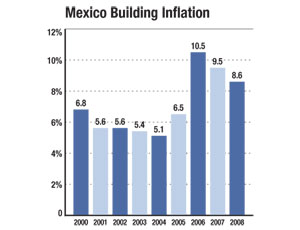The global recession has not missed Mexico, which is seeing many large commercial projects being postponed or cancelled. However, large industrial and public works projects are going forward as the government fights back by stepping up public-works spending. The result has been a mixed impact on prices of construction materials in Mexico.
“Steel prices have declined dramatically in the last three weeks,” says Javier Salas, manager of International Operations for Aceros Corey of Guadalajara, one of the largest fabricator/erectors in Mexico. “The price of rolled wide-flange has dropped 25%, although plate has held firm in pesos since there is not enough production capacity to keep up with industrial demand.”
Salas says the recent devaluation of the Mexican peso from 10.5 pesos per dollar to the current 13.5-to-14-peso per-dollar range has created challenges for Mexican builders as they pay for dollar-priced imported materials for projects that were bid and paid in pesos.
“We were bidding all our projects in pesos until the beginning of October,” says Salas. “Now we are back to a two-tier system. All our imported materials are quoted in dollars but our fabricating and erection are priced in pesos.”
Prices for materials such as rebar, which is 100% Mexican, have gone down. Structural steel also has gone down, but the price decrease is lessened by the rising cost of the dollars to pay for steel imports. Cement has stabilized, meaning price increases have stopped. Metals such as copper and aluminum are quoted in dollars, so we should see those prices increase, says Felipe Diaz de Leon, a managing partner with A.D.Tec, a Mexico City-based construction-management firm.
Both Salas and Diaz de Leon cite the cost of money, in both peso-dollar exchange rates and interest charged by Mexican lenders, as one of the key challenges that currently exist in Mexico’s construction markets.
Banamex and other Mexican banks may be making loans, but various sources say the interest rates are in the 12% to 14% range. “Many of the private commercial investors are people with very deep pockets who are financing projects with their own funds,” says Diaz de Leon.
One Mexican company that is having to face the money crunch is Mexican cement giant Cemex, which has been in the news for its struggles to refinance more than $6 billion worth of bank loans by the end of 2009. Cemex has sold off a subsidiary company in the Canary Islands and taken other measures to raise cash.
At the same time, Cemex is moving forward with acquisition plans for cement plants in the U.S., says Adrian Orta, a commercial building specialist with the U.S. Dept. of Commerce in Mexico City. It is joined by Cementos Cruz Azul, an ESOP-owned cement producer which has not ventured out of Mexico until now, but is also reported to be planning U.S. acquisitions.
Mexican builders’ attitude toward the current financial crisis probably stems from the 15-year period of raging inflation between 1981 through 1996, when the value of the peso plummeted year after year, says Salas.
“This is not as bad as 1995 was for us,” he adds. “The peso dropped overnight in value from 3.3 to 5.5 pesos per dollar and we had just invested in millions of dollars in new automated machinery for our fabrication facility. It took us eight years to dig ourselves out of that hole. This recession is a challenging environment, but we’ve seen worse times and can weather the storm.”
Diaz de Leon agrees, saying the only thing to do is keep moving forward. “Foreign investment is down from its high, but there are still a lot of companies coming to invest in Mexican manufacturing, hotels and infrastructure,” he says. “Mexican owners have had to face the problems of low and no sales and higher credit costs by making the decision to either stop work or deciding to go forward with their own money. There is still an attractive market and they want to be ready when that market regains its momentum.”


Post a comment to this article
Report Abusive Comment